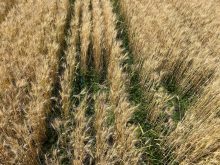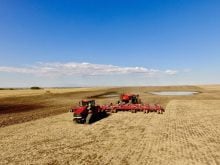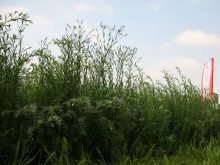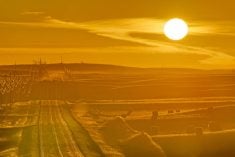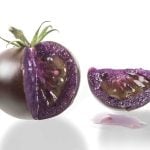An on-farm weather station doesn’t make the crop grow better, but farmers and agrologists using the technology say real-time information about precipitation, wind, temperature and soil moisture reserves can help guide decisions about if or when to apply crop inputs — and provide a good indication of what yield they might expect.
Field scouting is still important — you need to have that eye on the crop as the season progresses — but producers such as Craig Shand and Shannon Winny say the daily readings from weather stations on their farms help with crop management decision-making and their overall time management and efficiency. They have been using on-farm weather stations on their respective farms for several years.
Shand ,who farms near Cremona, Alta., about 90 km northwest of Calgary, is also owner of crop consulting service Chinook Agronomics. Winny is part of a family farming operation at Harris, Sask., about 80 km southwest of Saskatoon, and also owns crop consulting service GroWest Ag Ventures. She is also project manager at Discovery Farm at Langham, Sask.
Read Also

Health hazards are often overlooked risks on the farm
While quite different from the dangers posed by farm machinery, hazards such as loud noise or sun exposure require the same proactive attention, the Canadian Agricultural Safety Association says.
Several manufacturers are in the on-farm weather station market, with prices per unit ranging from a few hundred dollars for a basic unit up to $3,000 to $4,000 or more for a system with most of the bells and whistles.

Basic stations can include measurements of precipitation, temperature and wind speed, for example, and then producers can add on features such as soil moisture and soil temperature sensors, leaf wetness sensors, and salinity sensors — and subscribe to apps that provide yield forecasting and crop disease modelling.
READ MORE about at-home models: So you want to buy a weather station
Both Winny and Shand say there’s no hard-and-fast formula to calculate a return on investment from on-farm weather stations, but the payback and benefits can be found in many ways.
Although both have looked at different systems, they both use on-farm weather stations manufactured by Metos Canada — and both say an important “extra” they’ve included in their weather station setups is the soil moisture sensors. Also, while a few makes of weather stations need access to WiFi, the Metos stations and many others work wherever there is cellular service, and can transmit data to cell phones or desktop computers.

Monitoring variables
“We’ve found that on-farm weather stations can certainly improve day-to-day efficiencies,” Winny says. The family farm at Harris involves cropland spread over several miles, plus other farmland at Choiceland in the province’s northeast, about a 3-½-hour drive away.
Because the farmland near Harris is spread out, they use five weather stations, with soil moisture sensors at the various locations.
“During seeding season, for example, first thing in the morning you can have a look at data from the various weather stations, and perhaps at one field location there was half an inch of rain overnight,” Winny says.
“Knowing that, you might decide to send the drill in the other direction, to fields that didn’t get rain. There is nothing wrong with hopping in the truck and driving out to the various locations either, but if we can look at the weather data from overnight and then make plans for the day, that saves us time and we can get started with field work sooner. At a busy time of the year it can improve our efficiency.”
Winny says the number of weather stations a farm might need depends on those distances.
“If your farm is all one continuous block of land, one weather station may be sufficient,” she says. “But if you farm at various locations, which are several miles apart, you may want a weather station at each site. It is surprising how the weather can vary within a few miles.”
Winny says the weather station data can also help with crop input decisions. “Regardless of what system you buy, I think it is important to include soil moisture sensors, as well,” she says. She points to the 2016 and 2017 growing seasons as a good example.

In central Saskatchewan, growing conditions were particularly wet in 2016, then considerably dry in 2017.
“If you had just looked at rainfall in 2017, you might not be expecting a very good crop,” she says. “But the soil moisture sensors connected to the on-farm weather stations showed there was considerable ground water reserves in the soil profile.
“It is not a guarantee, but that soil moisture gives you some idea of yield potential — are you looking at a 45-bushel or a 65-bushel canola crop? Yield forecasting models can provide useful information in making decisions — should I top-dress fertility to optimize yield, or if the moisture isn’t there, maybe I should take my foot off the gas?”
Disease modeling
On Shand’s farm near Cremona, he monitors data from three weather stations, and subscribes to disease forecasting services from Metos.
“You still need to be out in the field looking at your crop, but the precipitation, temperature, humidity and soil moisture data collected by the weather station can be analyzed by the disease modelling algorithm to provide a disease risk rating,” he says.

In particular this year, he used weather station data and disease modeling to determine his risk for sclerotinia in canola and mycosphaerella blight in peas. As the Metos Canada database builds each year, the algorithm becomes much more accurate in assessing disease risk.
“You still have to make the final call, but the weather station data is one more tool you can use to make the decision. The disease modelling helped to reinforce our decision not to spray. And if you can save $30 per acre on fungicide cost, for example, then that’s a pretty good saving.”
Using on-farm weather station data fits well with the relatively new concept of Delta T in determining the ideal time to apply crop protection products, Shand adds.
The Delta T concept, developed in Australia, uses atmospheric moisture parameters to determine when to spray. Humidity, he notes, is an important factor in the effectiveness of spraying. Put simply, Delta T helps to avoid conditions when humidity is really high or really low.
“By analyzing temperature and humidity and other atmospheric parameters, Delta T provides essentially red, yellow and green indicators,” Shand says. “The recommendations are to avoid spraying when the Delta T is either too high or too low, with a middle range of two to eight being described as ideal.”
(More details on Delta T can be found on spraying specialist Tom Wolf’s Nozzle Guy website.)

Shand says the on-farm weather station data can yield useful in-season information about if and when top-up nutrients will be effective on a particular crop. And in fall and winter, when it comes time for planning next year’s crop, knowing soil moisture reserves can help guide seeding plans and yield expectations.
“Last year, for example, the soil moisture probe showed on our farm there was very little soil moisture reserve going into the 2024 growing season,” Shand says. “So we were going to need a lot of precipitation this year to produce a crop. So rather than target an 80- to 90-bushel yield on wheat, we were better off to target more like 65- to 70-bushel yield, and then see how the growing season played out.”
With current on-farm weather station technology, soil moisture sensors are hard-wired to the weather station. The harness allows the probes to be extended about 30 metres from the station. Shand usually places weather stations at the edge of the field, and extends the soil moisture probe out in to crop, avoiding the headlands. He places the soil moisture probe in the spring and removes them in the fall.
Knowing soil moisture conditions is useful information, he says, as he uses variable-rate technology on his own farm as well as with some clients.
“For me, the ideal situation down the road is to have wireless soil moisture probes than can be placed in each crop production zone,” he says. “That information will help to explain why yields can be so variable. I don’t expect it to be too long before wireless soil moisture probes are available.”
Both Shand and Winny have networks of clients with on-farm weather stations as well. Working over a relatively large geography in central and southern Alberta and central Saskatchewan, weather data from those stations provides an indicator of growing conditions over a good part of each province.
And they both say “on a selfish note, business-wise,” it helps with planning to be able to check weather data each morning, to see if it rained overnight. If it’s wet in in one area, they can redirect their field scouting services to a different area for a couple days until field conditions dry out. It helps to improve the efficiency of their agronomy services.
ALSO: Many choices with weather stations
With the increasing interest in on-farm weather stations over the past dozen years, a research manager at Olds College says there is lots of selection, so before making the purchase, the main question farmers need to ask is: what information do they want from the technology?
Herman Simons, manager of Smart Agriculture Applied Research, says the Olds, Alta. college has evaluated a number of weather stations over the past few years, and each system has its pros and cons.
“There is quite a range in prices,” Simons says. “Basic models cost a few hundred dollars and then it runs up to some units costing $10,000 or $12,000. So it is important for a farmer to do some homework and figure out what kind of information they want from a weather station.”

Simons says there are a few key points for producers to consider:
- Cost is an important one. Some companies sell the equipment to the producer, while with others there is no upfront cost; the producer pays rent or leases the units.
- How easy is it to set up the weather station?
- Many companies provide a basic unit, so a producer has to look at how easy it is to add features. What is the cost or subscription fee for add-on features, such as soil moisture sensors and disease modeling?
- What does the user interface look like? How easy is it to retrieve information from the weather station?
Olds College has an array of various makes of on-farm weather stations set up on the east side of the college campus so producers can see what on-farm weather stations look like.
And the college has done some research and evaluation of on-farm weather station features which is available in reports on the college website. — L.H.






